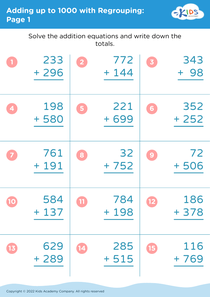Recognize patterns Adding up to 1000 Without Regrouping Worksheets for Ages 7-8
3 filtered results
-
From - To
Explore our "Recognize Patterns Adding Up to 1000 Without Regrouping" worksheets, designed specifically for children aged 7-8. These engaging activities help young learners identify numerical patterns, enhancing their addition skills while adding up to 1000 without the need for regrouping. Each worksheet fosters critical thinking, boosts confidence, and lays a solid foundation for more advanced mathematical concepts. Ideal for classroom or at-home learning, our resources make math enjoyable and accessible. By recognizing patterns, students will not only improve their calculation speed but also develop a deeper understanding of number relationships. Download our worksheets today and watch math skills soar!
Recognizing patterns, particularly when adding up to 1000 without regrouping, is essential for children aged 7-8 as it lays the foundation for advanced mathematical skills. At this age, children are transitioning from concrete to abstract thinking, and understanding patterns helps them to grasp concepts more intuitively. Recognizing how numbers interact and can be combined allows students to solve problems more efficiently and with confidence.
By focusing on patterns, teachers and parents can engage students in meaningful learning experiences, making mathematics less about rote memorization and more about critical thinking. Identifying patterns boosts numerical fluency and encourages mental math strategies, which can significantly enhance a child’s ability to maneuver through complex calculations later in their education. Furthermore, learning to recognize these patterns fosters persistence in problem-solving and helps students develop a growth mindset.
Moreover, practicing adding to 1000 without regrouping enables children to bond mathematical principles, making connections between numbers and enhancing their overall number sense. This strong foundational knowledge ensures that they are better prepared for future mathematical challenges, ultimately contributing to their academic success and fostering a positive attitude toward math in broader contexts.













